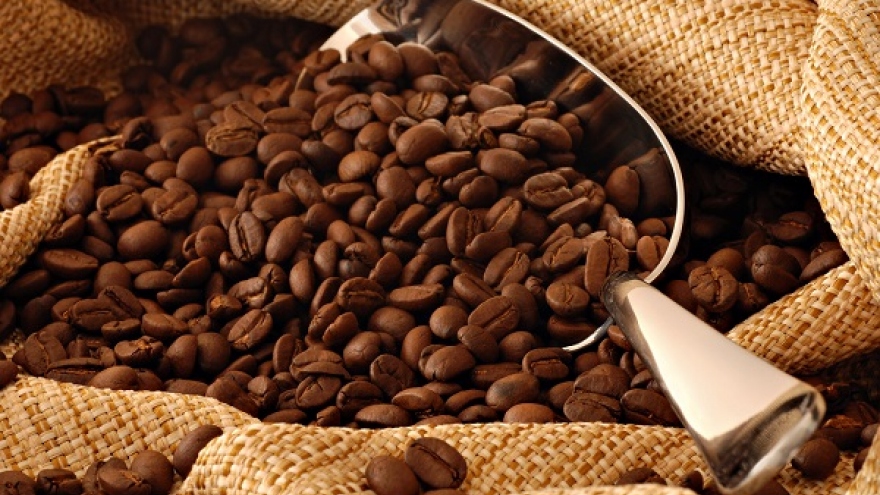2017 coffee exports may dip on low stock as uncertainty mounts
Coffee exports from Vietnam, the world's second-biggest producer after Brazil, may dip in the calendar year of 2017 due to thin carryover stocks while production of the next crop could be threatened by a lack of water, industry officials said.
A lower export volume from Vietnam, the largest producer of robusta beans, could tighten global supply of the bitter variety and inflate roasters' production costs, given a deficit already projected for the ongoing 2016/2017 crop year ending in September.
The world would face another coffee deficit this season, the third in a row, as production estimated at 151.62 million bags stays below consumption of 155 million bags, the International Coffee Organization said in its February report. Each bag contains 60 kilograms of beans.
 |
| Coffee beans are displayed at an exhibition in Hanoi in a file photo. Photo by Reuters/Kham |
Unseasonal rain in late October and early November last year had delayed harvest of the current crop, traders said. Earlier in 2016, the worst drought in decades damaged some robusta plantations in the Central Highlands coffee belt but did not cut into overall output.
Growers often pick robusta cherries from late October to January. Rain in most of the October-December period of 2016 had not only slowed the process but also disrupted drying.
"The rain has caused early blossom in some areas and the flowers are often ruined during the first phase of watering," Luong Van Tu, chairman of the Vietnam Coffee and Cocoa Association (Vicofa), said on March 13. Watering has now been under way in the region comprising five provinces.
While Vicofa has not made any output forecast for the next 2017/2018 crop, saying it was still too early, the losses of early flowers might lead to a smaller crop, Tu told VnExpress International.
He has been to Dak Lak Province in the Central Highlands over the weekend to attend a national coffee festival aimed at increasing sustainable production as well as boosting consumption of the beverage and promoting tourism to the region, which provides up to 90% of Vietnam's total output.
Tu said Vietnam's coffee exports this year could drop by around a quarter due to "very low stocks" brought forward from the previous season. He gave neither specific volume nor statistics for the stock.
The U.S. Department of Agriculture (USDA) estimated Vietnam's coffee stocks at the end of the previous season at 230,000 tons, or 3.83 million bags, down 40% from the previous season.
Vietnam exported a record 1.74 million tons between October 2015 and September 2016, based on Vietnam Customs data.
Exports in 2016/2017 are projected to fall around 12% to 1.56 million tons, the USDA said in its December 2016 coffee report.
Besides, higher domestic consumption and a rising export volume of finished coffee products would also reduce Vietnam's export of semi-processed beans, industry officials said.
In 2016, Vietnam's coffee shipments fetched US$3.34 billion, with around 10% coming from finished products, Tu said.
Vietnam has one of the world's fastest growing retail coffee markets, trailing only behind Indonesia, Turkey and India, global market intelligence Mintel said earlier this month.
Water
At a seminar on Sunday in Buon Ma Thuot, the capital city of Dak Lak, Vietnamese industry officials discussed ways to cope with climate change and ensure sustainable coffee production.
Climate change, with falling rainfall in recent years, and a third of the region's coffee trees being old have reduced yields, the Dak Lak government said in a statement late Sunday. Dak Lak is Vietnam's largest coffee planting province, producing a third of the country's total output.
Rainfall in March, the peak of the six-month dry season, is forecast to be similar to the average level in recent years in Dak Lak and also in Lam Dong Province, Vietnam's second-biggest grower, the region's weather station said. The wet season often returns in early May.
"Underground water is uneven this year, with some places reporting the water could recede 1.5 to two meters (5-6.6 feet) below last year's level," Tu said. The problem has emerged in all but the eastern part of the Central Highlands where rain has been sufficient, he said.
Ample supply of underground water will ensure success for the third phase of tree watering, while water shortages often lead to smaller cherries, affecting overall yields and output.
Traders said output forecasts made around June/July would provide more precise figures, after the rainy season returns.



